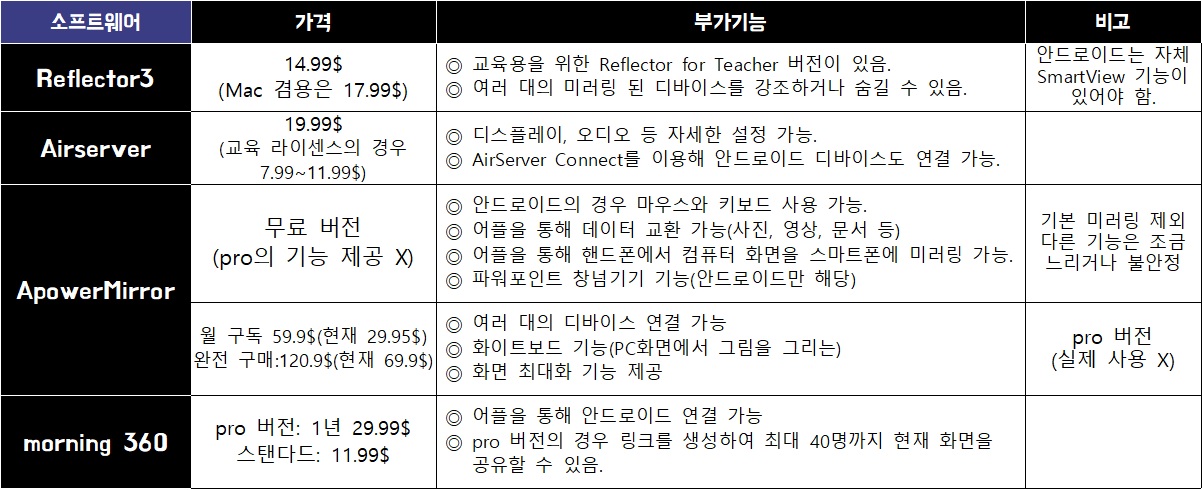Mirror iPad on Windows PC(1)
Let’s use the iPad properly!
Anyone who uses an iPad will want to use it to increase their productivity. But if you search for iPad on YouTube, you’ll find tons of videos about iPad productivity. This is a story that the iPad is highly usable, but at the same time it is also a disprove that many people are not using it properly. There are many ways to use the iPad, but the one we want to cover in this article is mirroring. In addition, this theme is also available for iPhone, so please refer to it.
1) Mirroring on iPad?
In general, there are two ways to mirror your iPad. One is to use ‘airplay’ or to purchase Apple’s ‘Lightning Digital AV Adapter’ and connect directly to the TV with an HDMI cable. Each of these two methods has advantages and significant disadvantages that cover them. First of all, in the case of ‘airplay’, the biggest advantage is that it is wireless and easy to connect. But to enjoy its benefits, you must have an apple TV! Have you ever seen Apple TV in your country? I’ve never seen one. Therefore, using airplay for mirroring means either that you have purchased an apple TV at home or that you have an apple TV in the place where you are going to give a presentation using mirroring, but it is difficult to expect both in terms of price and the environment in Korea.
In fact, the second alternative is realistic. The ‘Lightning Digital AV Adapter’ is being sold at the price of 59,000 won on Apple’s website. If you use this, you can connect the iPad directly to a monitor, including a TV, and display the iPad screen. This method has the advantage of being relatively inexpensive compared to apple TV and being able to connect anywhere with an HDMI cable. However, there are disadvantages in that it is inconvenient to move because it must be connected by wire and that it is impossible to quickly switch screens (to disconnect, you must disconnect the HDMI cable).
2) Another alternative?
Of course, each of the above methods has its own advantages, and if you use these methods well, you will be able to use mirroring according to your environment. However, in this article, I would like to suggest another method of mirroring. It is to use a program that recognizes the Windows PC I have as an apple TV. There are several types of such programs, the most representative of which are:
Common features of these programs include:
- Use airplay by recognizing PC or Mac as apple TV through a specific program.
- Because it utilizes WIFI, it must be connected to the same network as the PC.
- Simultaneously, several devices can be displayed on the PC.
Therefore, if these programs are used, not only can the disadvantages of the above two methods be overcome, but also the advantages of airplay can be used in the Korean environment. However, please note that a separate program (mostly paid) must be installed, and it is impossible to directly connect to the monitor without going through a PC.
3) Which program should I use?
Each program has different characteristics. There is a link to the site in the program name above, so the best way is to look it up yourself. However, if you are having trouble, please refer to the arrangement below. It is reliable because it is the result of installing and using the free version of all four programs. However, it is recommended that you who are reading this article install the free version and use it yourself before purchasing it, rather than purchasing it right away.

4) What is my decision?
Actually, the first thing I bought was the Reflector 3. In addition to the price advantage, the ability to add or hide the device was also considered an advantage. However, after purchase, I ended up getting a refund. The reason was the inconvenience in using Android. First of all, I think I should talk about my usage environment.
- classroom
- Your device: iPhone, iPad
- In addition to your own device, students’ devices also need to be connected.
In fact, if you only use iPad and iPhone, I think the Reflector 3 is more suitable. However, due to the characteristics of Korea, most students use Android. In this environment, when mirroring by connecting students’ devices, it is quite inconvenient in the case of Reflector 3. In order to use it on Android, you need to have Samsung’s “smart view” mirroring function or download an app, and this app costs 9,500 won. (I’m not sure about this, because the app is paid, so I haven’t tried it.) In the past, it seems to have been possible using the Google Home app, but now that function seems to have disappeared. Therefore, in the case of older smartphones without the “smart view” function, mirroring is not possible. Eventually, I switched to AirServer, which offers a free app for Android.
What is Next?
Therefore, in the next article, I will review how to use Airserver and at the same time review ApowerMirror, which has various features even in the free version.